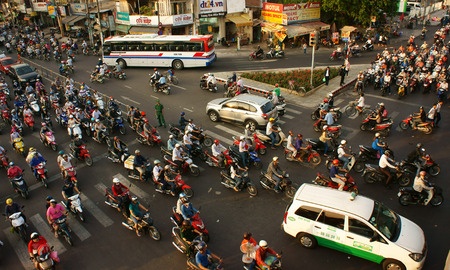28 October, 2017
Vietnam’s economic success story is evident in the rapid development of its big cities. However, while the country’s growth has outpaced its neighbours, so has its debt; a factor that threatens to de-rail growth. Not least of all because of the impact on the government’s ability to give guarantees to underpin privately-financed infrastructure.
Over recent decades, the government has spent significantly. Priority has been given to roads, export zones and other critical infrastructure. This is evident across the country, where highways, tunnels, factories, airports and metro systems are being expanded, or built from scratch, at an incredible pace.
The biggest macroeconomic challenge facing Vietnam today is sustaining that growth. The government needs to be more rigorous about how it spends money, leveraging it better to attract and benefit from private funds rather than prop up State-owned entities. The looming spectre of public debt will need to be tackled before the country finds itself in a precarious position.
Vietnam’s total public debt as of mid-July 2017 reportedly stood at US$94.6 billion, or about US$1,038 per capita. In fuelling the country’s celebrated growth, public debt has increased consistently, from 36% of GDP in 2001 to about 62.4% in 2016. According to an IMF forecast, it will hit 63.3% and 64.3% in 2017 and 2018, respectively, while the self-imposed public debt ceiling is set by the government at 65% of GDP for 2020.
Vietnam’s public debt compares unfavourably with the rest of the region, with Thailand coming in at 41 percent of GDP and Malaysia at 56 percent, according to the World Bank.
The annual growth of public debt during 2011-15 was 18.4 per cent, triple the annual GDP growth rate, which averaged about 5.9 per cent over the period.
A squeeze on guarantees
In an effort to tackle the ballooning public debt, the Ministry of Finance (MoF) announced changes to regulations on Government guarantees earlier this year. The adjustment is one of the regulations stated in the Government’s Decree 04/2017/ND-CP (Decree 04), superseding Decree 15/2011/ND-CP (Decree 15), issued on February 16, 2011.
Taking effect from March 1, the maximum level of Government guarantees for a programme or project was reduced from the previous level of 80 percent. Decree 04 replaces this with a three-tiered cap on the amount of guaranteed debt as a percentage of the investment capital depending on the size or importance of the project, each lower than the cap established in Decree 15. In all cases this is far lower than the golden days of Vietnam’s early privately financed infrastructure projects like the Phu My 3 and Phu My 2.2 power projects which both enjoyed near total guarantees.
The current highest level of guarantee, set at 70 percent, applies to projects that must be implemented on an urgent basis, and have been approved by the National Assembly or the Prime Minister. Secondly, for projects whose total investment is at least VND2.3 trillion (US$102 million) and have been approved by the Prime Minister, the maximum proportion guaranteed by the Government is 60 percent. A cap of 50 percent will be applied to other projects.
In continuing to restructure of the country’s public debt with more stringent monitoring of projects, the decree aims at tightening the provision of Government guarantees and enhancing the management of public debt.
However, at a time when Vietnam needs to develop much infrastructure, notably in the energy sector, and requires substantial foreign investment to do so, Decree 04 makes it more difficult for private investors to obtain MoF Guarantees for projects.
Ticking debt time bomb
Taking the energy sector as an example, questions remain over EVN’s economic health. Tariffs on electricity have long been maintained at below cost levels. The policy of low subsidised tariffs to maintain the competitiveness of domestic industry and keep consumers happy is putting pressure on the government and EVN’s balance sheet.
The average retail electricity tariff stood at just above US$0.08/KWh as of 2016, the lowest in Southeast Asia, and only just above EVN’s average generation cost of US$0.075/KWh (excluding transmission and distribution costs). This has depressed sector cash flow and contributed to EVN’s rising debt.
This has raised concerns among private sector investors over EVN’s ability to pay for electricity generated as the single buyer, while the current low retail tariffs mean that investors are not confident of negotiating adequate prices for generation projects.
With the situation likely to continue, EVN’s financial position will surely deteriorate, leaving it with unsustainable debt and unable to finance capital expenditure. This would force private sector investors to seek increased government guarantees. Unfortunately, as mentioned above, the government is looking to rein in such largesse. As Vietnam’s economy grows, the previously abundant soft loans and ODA are beginning to dry up, meaning that the sources of support for private finance are becoming harder to find.
In order to reduce risk, the developers of major infrastructure projects may need to seek out private insurance groups or institutions like the World Bank’s Multilateral Investment Guarantee Agency (MIGA). However, these options obviously don’t come without their own costs. Investors, and ultimately end consumers, will have to take the hit.
Much of Vietnam’s current fiscal position can be blamed on poor management. The state-owned giants that have lost their repayment ability on Government-guaranteed loans are passing on the burden to the Government.
The sluggish privatisation of State-owned enterprises means that inefficiency will continue. The sooner this process is completed, the better for the economy as a whole. Measures like reducing government guarantees may be prudent, but if Vietnam wants to maintain its economic momentum serious action is needed to first untangle the mess of intra-State bad debt.
For further information, please contact:
Giles T. Cooper, Partner, Duane Morris
gtcooper@duanemorris.com

.jpg)





